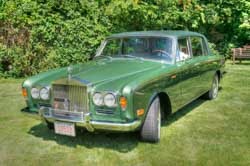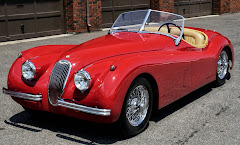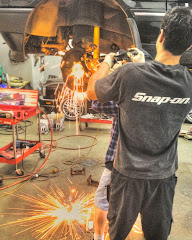If you live in snow country you know convertible and sports
car season is coming to an end. Soon it
will be time to put our pets away till next year. In this article I’d like to offer some
pointers for storing late model collector cars.
Start by filling your car with fuel and pouring in the
correct amount of fuel stabilizer. I
suggest Sta-Bil brand but alternatives are available. A full gas tank minimizes the chance of
condensation which happens when water vapor from the air condenses on the
inside of the gas tank as temps drop in the evening. If this happens every day in a car that’s in
storage you can accumulate a great deal of water in the fuel. Filling the tank to the top will prevent it.
I also suggest pouring in a bottle of octane booster as the
fuel will lose octane rating the longer it is stored.
Note: cars built
after the 1990s have sealed fuel tanks which should not allow free circulation
of vapors. For these cars filling the
tank is less important and indeed you may want to keep their fuel level low so
you can fill with fresh gas in the spring.
Run the car at least 30 minutes to get it thoroughly warmed
up; an hour’s hard run is better. You
want to make sure you have boiled any stray moisture out of the engine and
exhaust system before shutting the car off for the season.
You want to store the car with reasonably clean oil; some suggest changing oil right before winter storage while others argue for changing the oil first thing in the spring. In my opinion, the oil in your collector car should always be fairly clean so that no special attention is required for storage. As a practical matter, I can say with confidence that cars often go into the shop to be "checked over for spring" where shop visits to "prep for winter" are fairly uncommon.
If you don't know the age of your coolant I suggest you either change it (most cars should get fresh coolant at 2-5 years intervals) or at least tests its ph to make sure it has not become corrosive.
You want to store the car with reasonably clean oil; some suggest changing oil right before winter storage while others argue for changing the oil first thing in the spring. In my opinion, the oil in your collector car should always be fairly clean so that no special attention is required for storage. As a practical matter, I can say with confidence that cars often go into the shop to be "checked over for spring" where shop visits to "prep for winter" are fairly uncommon.
If you don't know the age of your coolant I suggest you either change it (most cars should get fresh coolant at 2-5 years intervals) or at least tests its ph to make sure it has not become corrosive.
The next step is washing your car, and vacuuming and
cleaning the interior and trunk. Spots
that wash off easily now may not be so removable if left till next spring! If your car is going to be stored in an area
where mice may invade I suggest putting mothballs or some other repellant in
the car to improve the chances that they won’t move in.
Check all your fluids and top them off right to the full
lines before parking the car. Make sure
the antifreeze protection is good and the windshield washer system has solvent,
not water, so that it does not freeze.
Spray all the door seals and the trunk seal with silicone
spray before putting the car away. Oil
the hood, door, and trunk hinges, too.
If there are throttle linkage pieces on the engine I’d hit them with
oil, and I’d also oil any moving pivots (like the parking brake linkage) under
the car.
Before parking your car I suggest inflating your tires to
the maximum pressures as shown on the tire sidewall. This will minimize the tendency of your tires
to develop flat spots as they sit.
Switch off the radio, heat, air conditioner and all other
accessories before you shut the car off.
The will minimize the electrical load and transients when you reconnect
power next spring. It’s your best way to
prevent electrical failures.
Drive your car into the spot where it will be stored. Close the windows, and shut off the engine
and remove the key. If your car was made
before the airbag and electronic engine management era you can go ahead and
disconnect the battery. If you have a
newer car – wait a minute! Newer cars
often need as much as twenty minutes for their computers to store data and
shift to low power mode. If you
disconnect the battery before that process is complete you can set fault codes
that will require a trip to the shop to correct next year.
In the worst case, disconnecting the battery can even cause
major electronic systems to fail. Land
Rover – for example – has a problem with this on their 2000-2005 Range
Rovers. Disconnecting the battery too
quickly can send the navigation computer to never-never land where the only
cure is a new $1,000+ unit. Be patient
and avoid problems.
If you are disconnecting the battery I certainly suggest you
take the keys out of the vehicle. The
reason – when you connect the battery in the spring there is always a chance
the central locking system will power up and lock the vehicle. If that happens and the keys are inside,
you’re stuck!
Modern batteries lose about 10% of their charge every month
while sitting. If you park the car at
the beginning of November a good battery will still have enough juice to start
the car in March. Connecting a trickle
charger will keep it at 100% buy you’ll need access to an electrical outlet.
The best way to protect your tires is to put wood blocks
under the suspension at all four corners, lifting the car’s wheels slightly off
the ground. That will ensure the tires
are round next season.
Do not set the parking brake. Leaving the parking brake under tension all
winter may well result in a brake that won’t release next spring.
If you have a convertible you should usually store the car with the top up to prevent shrinkage. Once it's closed don't open it until you have a warm day to heat the canvas unless you are in a heated space in which case that does not matter. Every year we see plastic rear windows that split when opened on a cold day.
If you have a convertible you should usually store the car with the top up to prevent shrinkage. Once it's closed don't open it until you have a warm day to heat the canvas unless you are in a heated space in which case that does not matter. Every year we see plastic rear windows that split when opened on a cold day.
Some people prefer car covers; others leave their pets
uncovered. There’s one school of thought
that says pulling the cover off and on will scratch the car and another that
says the protection is invaluable. If
you want to get a cover and the car is indoors I recommend the heavy
flannel. If it’s outdoors Technalon is
the ticket.
These tips will maximize your chances of an uneventful
winter of storage. I wish you the best
of luck with executing the plan. And
remember to keep your insurance in force.
If there’s a water leak in the garage, or mice eat holes in the seats .
. . those things are covered by comprehensive insurance in most states. The times you are not driving the car may
well be the times you need insurance most.
John E Robison
John Elder Robison is the general manager of J E Robison Service Company, independent restoration and Bosch Authorized Car Service specialists in Springfield, Massachusetts. John is a longtime technical consultant to the Land Rover, Porsche, and Rolls Royce Owner's Clubs, and he’s owned and restored many of these fine vehicles. Find him online at www.robisonservice.com or in the real world at 413-785-1665


























No comments:
Post a Comment